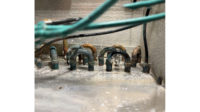Adding refrigerant to equipment today is a relatively expensive repair. The cost of refrigerant is high, and with the phasedown of high-GWP refrigerants for more environmentally friendly alternatives, the cost of these refrigerants will continue to rise. While servicing equipment, technicians should always be on the lookout for sources of potential future leaks and, of course, follow good service practices to prevent creating a leak.
There are many times a refrigerant leak can be prevented if, during a repair or maintenance inspection, a technician takes a little extra time to look over the system and make minor changes or recommendations to a customer for some extra work to prevent a future leak. The customer may not approve the extra work, but at least they were notified of the potential issue — and if a leak develops in the future, they cannot blame you or your company for the extra work and refrigerant now needed.
For example, during a repair or inspection, check any pipe clamps used on the equipment. A loose or missing brace on a pipe clamp can lead to a rub out and a refrigerant leak. Also look for any refrigerant lines in direct contact with each other, which can also lead to a rub out. Inspect the capillary tubes used on pressure switches — some technicians will add a bridge of silicone across any looped sections to prevent a future leak.
A few years back, we were working on a refrigeration rack for a small grocery store and noticed that some of the pipe clamps for the discharge piping were loose and some were missing. We notified the store owner of the issue, and at the time, he said he would have his maintenance technician take care of it. A year later, we were back on the job repairing a leak.
Sometimes technicians are the cause of a loss of refrigerant. For example, any Schrader cores depressed during an inspection or repair should be checked for potential leaks before leaving. A Schrader core may not seal properly after being depressed. And, of course, always make sure any Schrader valves have their caps with a good rubber gasket installed before leaving the job.
When replacing piping, if the section of piping has a vibration loop, be sure the new section of pipe also has a vibration loop installed. Eliminating a vibration loop can lead to a future leak. When securing panels back on, be sure the screw will not puncture or rub against any coil or refrigerant piping.
On reach-in coolers and freezers, it is not uncommon to need to pull out the condensing unit from under the cabinet to make a repair. Typically, the refrigerant lines are coiled to allow for the condensing unit to be moved out. However, you need to be careful not to damage the lines as you move the condensing unit, especially on older units. The tubing may have hardened over time and will kink or crack when stressed. Sometimes on older systems, I will try to make the necessary repairs without pulling out the condensing unit.
Preventing refrigerant leaks is a little time consuming, but it is good business practice for you and your customers.








